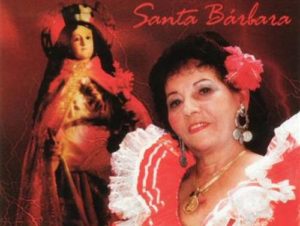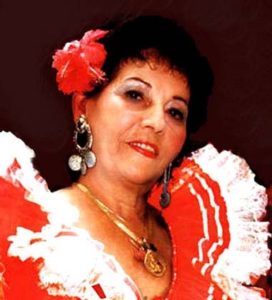CELINA GONZÁLEZ, THE OWNER OF THE CUBAN ‘PUNTO GUAJIRO’. (CELINA AND REUTILIO). VIDEOS
The music of the fields of Cuba, like the peasant music of the entire Caribbean, has a strong Hispanic influence. Guajira, Jíbara or Llanera, represents a very important aspect in the spectrum of popular music, including salsa through instruments, themes, and voices.
The Cuban point is peasant music of Spanish roots, with strong Andalusian influence transformed into Cuban lands. It is performed with the accompaniment of Tres, Laúd, Guayo, Clave, and Güiro. It has a lot to do with the Décima and the Tonada, and depending on the area where it is sung, it adopts other modalities.
Celina González Zamora “La Dueña del Punto Guajiro” was born in Jovellanos, Matanzas province, Cuba on March 16, 1928, and is one of the most important characters when it comes to studying the incidence of Cuban Guajira music in the Caribbean environment. , and beyond. She revolutionized her own musical genre by incorporating elements of African heritage music at Punto y la Guajira. When she was very young, her parents Gregorio González and Benita Zamora took her to Santiago de Cuba.
https://youtu.be/Y06C82oAz9o
CELINA Y REUTILIO SING “QUE VIVA CHANGÓ” (VIDEOS)
“I grew up in the heat of Santiago de Cuba, among old troubadours, old soneros, in the warmth of that town. Santiago was always a hotbed of revolutionary ideas, of a revolutionary whole, and not only in politics. life together with the landscape. There I learned to love the meaning of the relief of the Royal Palm on the horizon “he said in an interview.
She always had a Cayenne in her hair and in recent times she accompanied her throughout Lazaro, her son, whom no one called by her name but by her father, now deceased, Reutilio. Her son made a duet with her and with the name of her father, her tradition was not lost: Celina and Reutilio. But it was Lazarus.
ARTISTIC CAREER
She started as a professional when she was almost 20 years old. Of course, before she sang in the guateques, and later in the touches of Santiago. Then she sang, Punto Cubano. In an interview with Lil Rodriguez from TeleSur she refers:
“When I was 20 years old, I came to the radio led by a young man who would become my boyfriend and then my husband, but who began only as my co-worker, Reutilio Domínguez, a guitarist born in Guantánamo, who did with me a duo called like this: “Celina y Reutilio.” The two of us started on a radio station in the Oriente province, on ‘Cadena Oriental’. We achieved, more than success, notoriety. It felt what we did. Ñico Saquito, our great promoter towards the whole island. Ñico was already a legend and he discovered us on the radio. He managed to get us to make some recordings on the station, and he himself took them and went to Havana to listen to them. Laureano Suárez, the popular “suarito”, at that time one of the most popular radio broadcasters in Cuba. And look. Suarito liked the work we were doing and decided to hire us for a week. That’s how Reutilio and I, sponsored by Ñico, traveled from Santiago to Havana. ”
If my landscape changed in Santiago, my life changed in Havana, thanks to a dream.
A dream?
“It turns out that when we got to the city Reutilio and I stayed where a friend of mine and went to sleep. It was our first Havana night. While I was asleep, Santa Bárbara Bendita appeared to me in my dream and told me to get up and copy the I got up and copied the lyrics, as in a dream, and the Saint also gave me the music. When I got up I knew it by heart. I never forgot it. I told Reutilio and I sang it to him now. He fascinated him, making some arrangements for the melody. I decided that with that song I would make my radio debut in Havana. Suarito’s contract was for one week. The success was so tremendous that the contract was extended that day immediately, for one year “.
https://youtu.be/9iL0a1kCeTg
CELINA Y REUTILIO SING “A SANTA BARBARA”. (VIDEOS).
“We, remembering, found that this song” Que viva Changó “is the first that links Guajira music with themes of Yoruba origin, black. It should be remembered that the black theme has its rhythmic formats and that peasant music also has a literature particular, bucolic, guajira, well. But that of singing to Changó with Laúd and Tiple “.
On the subject, classic among the classics of Cuban popular music, it makes a direct allusion to the musical and revolutionary ancestor, I always speak of its saints and is emphatic in pointing out that it has never denied its faith.
AWARDS AND HONORS
Celina has received tributes in many countries. In Colombia, she is a true idol. Mexico welcomes her with great affection, as do Spain, Peru, and Germany. She was in the United States with Benny Moré and also with Barbarito Diez. Her tours to London, Paris, and Athens were successful.
Celina produced more than 40 albums, with which she won several awards, including the Gold Record of Africa and the highest honors of music in Cuba. In 1980 she won the Egrem Silver Record Award for the album Celina. This was the first of many awards. In 1984 she received the National Vanguard for her artwork and won a trip to the Soviet Union and Bulgaria with her son. In 1984 she won the Best Singer award at the 27th International Music Festival in Cali, Colombia and after a successful tour of Europe in 1988 she recorded a session for the BBC.
The albums ‘The rich harvest’ and ‘From Havana I bring you’ was well received, and she was nominated, unsuccessfully, for a Grammy in 2001 in the category ‘Best Traditional Tropical Latin Album’, for her CD Fifty Years … like a queen. Instead, the album won the Cubadisco award for the same year.
Celina González opened a historical gap to the music of her country in the peasant-Yoruba link and she continued there as if nothing had happened.
She passed away on February 4, 2015, at the age of 87 covered by the immense affection of the Cuban people. On October 20 of that same year, on Cuban Culture Day, her sculpture was unveiled in the now legendary Wax Museum in the city of Bayamo, Cuba.
She was and still is Celina González. The Cuban Point in person.
CELINA GONZALEZ, LA DUEÑA DEL PUNTO GUAJIRO CUBANO. (DUO CELINA Y REUTILIO) VIDEOS
La música de los campos de Cuba, como la música campesina de todo el Caribe tiene una fuerte influencia hispánica. Guajira, Jíbara o Llanera ella representa una vertiente bien importante en el espectro de la música popular, salsa incluida mediante instrumentos, temáticas y voces.
El punto cubano es música campesina de raíz española, con fuerte influencia andaluza transformada en tierras de Cuba. Se ejecuta con acompañamiento de Tres, Laúd, Guayo, Clave y Güiro. Tiene mucho que ver con la Décima y con la Tonada, y según la zona donde se cante adopta otras modalidades.
Celina González Zamora “La Dueña del Punto Guajiro” nació en Jovellanos, provincia de Matanzas, Cuba un 16 de marzo de 1928 y es uno de los personajes más importantes a la hora de estudiar la incidencia de la música guajira de Cuba en el entorno caribeño, y más allá. Ella revolucionó su propio género musical al incorporar elementos de la música de herencia africana al Punto y la Guajira. Siendo muy pequeña sus padres Gregorio González y Benita Zamora la llevaron para Santiago de Cuba.
“Crecí al calor de Santiago de Cuba, entre viejos trovadores, viejos soneros, en la calidez de ese pueblo. Santiago fue siempre un hervidero de ideas revolucionarias, de un todo revolucionario, y no sólo en la política. En Santiago se me viró la vida junto con el paisaje. Allí aprendí a amar el significado del relieve de la Palma Real sobre el horizonte” dijo en una entrevista.
https://youtu.be/HlMsZ8mTGHs
CELINA Y REUTILIO CANTAN “VIVA YEMAYA” (VIDEOS)
Siempre tuvo una Cayena en sus cabellos y en los últimos tiempos la acompañaba en todo Lázaro, su hijo, a quien nadie llamaba por su nombre sino por el del padre, ya fallecido, Reutilio. El hijo hizo dúo con ella y con el nombre del padre no se perdió la tradición: Celina y Reutilio. Pero era Lázaro.
CARRERA ARTISTICA
Comenzó como profesional cuando ya casi iba a cumplir los 20 años. Claro, antes cantaba en los guateques, y luego en los toques de Santiago. Entonces ella cantaba, Punto Cubano. En una entervista con Lil Rodriguez de TeleSur refiere:
“Ya para cumplir los 20 años llegué a la radio llevada de la mano de un joven que se transformaría en mi novio y luego en mi esposo, pero que comenzó solo siendo mi compañero de trabajo, Reutilio Domínguez, guitarrista nacido en Guantánamo, quien hacía conmigo un dúo que se llamó así: “Celina y Reutilio”. Los dos comenzamos en una radio de la provincia de Oriente, en la ‘Cadena Oriental’. Logramos, más que éxito, notoriedad. Se sentía lo que hacíamos. Así lo sintió Ñico Saquito, nuestro gran impulsador hacia toda la isla. Ñico era ya una leyenda y él nos descubrió en la radio. Logró que hiciéramos unas grabaciones en la emisora, y él mismo las tomó y se fue para La Habana a fin de que las escuchara Laureano Suárez, el popular “suarito”, por aquél entonces uno de los más populares locutores de Cuba. Y fíjate. A Suarito le gustó el trabajo que hacíamos y decidió contratarnos por una semana. Fue así como Reutilio y yo, apadrinados por Ñico, viajamos desde Santiago hasta La Habana”.
Si en Santiago se me cambió el paisaje, en La Habana se me cambió la vida, gracias a un sueño.
¿Un sueño?
“Resulta que cuando llegamos a la ciudad Reutilio y yo nos alojamos donde una gente amiga y nos acostamos a dormir. Era nuestra primera noche habanera. Estando yo dormida se me apareció Santa Bárbara Bendita en el sueño y me dijo que me levantara y copiara la letra que me iba a dictar. Yo me levanté y copié la letra, como en sueños y la Santa me dio también la música. Cuando me levanté me la sabía de memoria. Nunca se me olvidó. Le conté a Reutilio y se la canté y a él le fascinó, haciéndole algunos arreglos para la melodía. decidí que con esa canción haría mi debut radial en La Habana. El contrato de Suarito era por una semana. El éxito fue tan tremendo que el contrato se extendió ese día inmediatamente, por un año”.
https://youtu.be/EOL3qnk3poo
CELINA Y REUTILIO CANTAN “A SAN LAZARO” (VIDEOS)
“Nosotros, haciendo memoria, encontramos que ese tema “Que viva Changó” es el primero que vincula la música guajira con temas de origen Yoruba, negro. Conviene recordar que la temática negra tiene sus formatos rítmicos y que la música campesina también tiene una literatura particular, bucólica, guajira, pues. Pero eso de cantarle a Changó con Laúd y Tiple”.
En el tema, clasico entre los clásicos de la música popular cubana hace alusión directa al ancestro musical y revolucionario, siempre hablo de sus santos y es enfática en señalar que nunca ha renegado de su fé.
PREMIOS Y HONORES
Celina ha recibido homenajes en muchos países. En Colombia es un verdadero ídolo. México la recibe con mucho cariño, al igual que España, Perú y Alemania. Estuvo en Estados Unidos con Benny Moré y también con Barbarito Diez. Fueron exitosas sus giras a Londres, París y Atenas.
Celina produjo más de 40 discos, con los que obtuvo varios premios, entre ellos el disco de Oro de África y los más altos honores de la música en Cuba. En 1980 ganó el premio Disco de Plata de Egrem por el álbum Celina. Este fue el primero de muchos premios. En 1984 recibió la Vanguardia Nacional por su trabajo artístico y ganó un viaje a la Unión Soviética y Bulgaria con su hijo. En 1984 ganó el premio a Mejor Cantante en el 27º Festival Internacional de Música en Cali, Colombia y luego de una exitosa gira por Europa en 1988 grabó una sesión para la BBC.
Los álbumes ‘La rica cosecha’ y ‘Desde La Habana te traigo’ fueron bien recibidos, y fue nominada, sin éxito, a un Grammy en 2001 en la categoría ‘Mejor Álbum Latino Tropical Tradicional’, por su CD Cincuenta años … como una reina. En cambio, el álbum ganó el premio Cubadisco por el mismo año.
Celina González le abrió un boquete histórico a la música de su país en la vinculación campesino – yoruba y siguió por ahí, como que si nada.
Falleció el 4 de febrero de 2015, a los 87 años cubierta por el afecto inmenso del pueblo cubano. El 20 de octubre de ese mismo año, en el Día de la Cultura Cubana, fue develada su escultura en el ya legendario Museo de Cera de la ciudad de Bayamo, en Cuba.
Fue y sigue siendo Celina González. El Punto cubano en persona.
DISCOGRAFIA
Albums
La Rica Cosecha
Desde la Habana te Traigo
Cincuenta Años… Como una Reina
Agencies/ Wiki/ TeleSur/ Lil Rodriguez/ Internet Photos/ YouTube/ Arnoldo Varona/ www.TheCubanHistory.com
THE CUBAN HISTORY, HOLLYWOOD.












